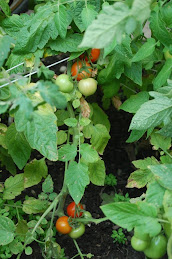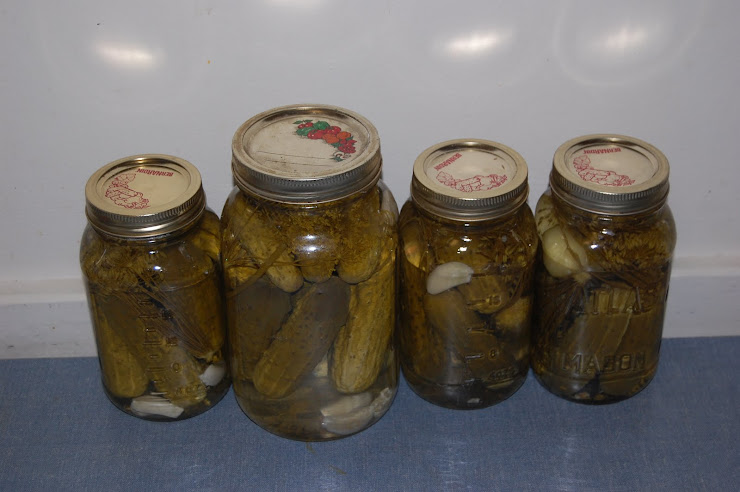
I don't know about you but September was a bit of blur around here and I can't believe it's October already. The gardens are almost bare, the shelves are filling up and there's a bit of room in the fridge again finally. Preserving season is winding down but there's still a lot to do!
As I mentioned previously my gardens were pretty much a bust this year- between the erratic weather and the ridiculous amount I lost to squirrels and raccoons, there wasn't much of a harvest to be had. I'm still picking a few tomatoes and peppers and the salad greens are enjoying all the rain and cooler temps but pickings are slim. Thankfully it's been a fabulous year for foraging and freebies!
Wanna stretch your food dollars? Got some time on your hands? Consider volunteering with local food initiatives and other food related events! Beside keeping in touch with what's happening in your community and giving a much needed hand, there's almost always leftovers to be shared amongst the people who stay behind to clean up! In the past few weeks I brought home 30 ears of cooked corn on the cob, thawed premade hamburger patties, a pound of barely opened butter, an unopened box of crackers, and more fruit and veggies than I can list here. Between this and all of the foraging I've been doing, there's been plenty of produce to put up for winter. Here's some of the preserving I've done recently, with recipes and links.
Corn Cob Stock:

After cutting the niblets off of 30 ears of corn for freezing, I chucked the cobs into a pot of water and left them to simmer for a few hours. When it was done I had 2 litres of rich corn stock which I froze for soup. The idea and directions came from Local Kitchen.

Autumn olives or olive berries are so named because the leaves resemble olive leaves. They produce clusters of reddish orange berries that are higher in lycopene than tomatoes! These beautiful jewels make a really yummy tart jam- I did some alone and some with grapes.

Olive Berry Jam:
6 c ripe autumn olive berries.
1 c water
2 ½ cups of sugar
1/2 package liquid pectin
Add water to berries and bring to a boil then simmer for 20 minutes until berries are soft.
Mash and strain through a sieve to remove seeds- should make about 4 cups of pulp. Add sugar and heat till boiling. Add liquid pectin and heat to a rolling boil. Check for set at one minute. Fill sterilized jars (I used 125 ml ) leaving 1/2 inch headspace and process for 10 minutes.
Chilies,chilies and more chilies:
I love the hot stuff! The Russian however does not. We compromise by making almost everything mild and then I add heat to my portions after the fact. Of course different dishes call for different flavours so I like lots of choices in my hot condiments. Here are two very simple recipes for preserving hot chili peppers.

Peri Peri sauce (Portugues style hot sauce)
Use the long red hot peppers for best flavour but any hot pepper could be subbed.
12 large hot red peppers
1 1/2 tbsp course salt (or to taste)
2/3 cup vinegar.
Stem and seed peppers- wear gloves!
Chop into smaller pieces and puree in a blender or food processor. Add salt and vinegar and puree until smooth. In a large sauce pan heat puree until slightly boiling, allow to simmer for 5 minutes. Turn off heat and allow to cool. This allows the air bubbles to dissipate. Stir thoroughly and reheat to a low simmer and pour in hot sterilized jars (I used 6 x 250 ml but this varies depending on the size of the peppers). Using a plastic or wooden tool, remove air bubbles. Leave 1/2 inch head space, seal and process for 15 minutes in hot water bath.

Peri peri sauce usually includes oil but you should never can anything containing oil as it can reduce the effectiveness of the canning process and allow spores to survive. Instead I add 1 tblsp of olive oil to a jar once it's opened and then refridgerate it.
Chili Garlic Paste (adapted from Viet World Kitchen)
Unlike the peri peri sauce I make small batches of this and don't bother to can it- just pop it in the fridge. It isn't acidic enough as it stands for safe waterbath canning.
1 cup hot chiles (e.g. cayenne, habanero, jalapeno, serrano, Thai, or a combination of them), stemmed and chopped- leave the seeds in for extra heat!
4-5 cloves garlic, chopped
1 teaspoon salt
1 tbsp sugar
2 tbsp white vinegar

Put all the ingredients in food processor. Process to a coarse texture. Transfer to a small saucepan, bring to a vigorous simmer over medium heat, lower the heat to gently simmer for about 5 minutes. Taste and adjust the flavor with add extra salt or sugar. Remove from the heat and set aside to cool. Transfer to a jar and store in the refrigerator. Makes 1 x 250ml jar.

Green Tomatoes
As the warm weather winds down the chance of those last few tomatoes actually ripening on the vine gets less likely, but tomatoes that are picked totally green tend to get only partially ripened before they start to look shrivelled and unappetizing. By roasting the ones that are nearly ripened but not quite red, you can concentrate the available sugars and make a versatile sauce. You also get to use up bits of herbs and any other less than perfect veggies.

Roasted Nearly Ripened Tomato Sauce.
6- 10 partially ripened tomatoes (I sometimes use a few over ripened ones as well but not if they are already starting to go off).
Ends and stalks of herbs that you've harvested for other things- basil, thyme, oregano and rosemary all work well but tarragon, sage and savoury are also okay.
Carrot tops, celery leaves or bits of both cut up. You can also use sweet peppers.
1 onion cut in small chunks
2-3 cloves of garlic, smashed (don't worry about removing the paper skins)
1/2 tsp salt
Cut tomatoes in half or quarters and lay them in a baking dish. Cover with bits of herbs, onions, garlic and other veggies. Add 1/2 cup of water. Sprinkle with salt. Bake in 300 degrees F oven for 30 -40 minutes or until all veggies are soft.

Remove dish from oven and strain contents through a wire mesh strainer or use a food mill. (note if you have the time, you can allow the dish to cool and remove the skins from the tomatoes by hand prior to putting it through the strainer- it does make pushing the pulp through easier but it's not necessary)
Add pulp and juice to a saucepan and cook down over med heat. Taste and add salt , pepper and a bit of sugar if it seems too tart. Cook until it reaches a good sauce consistancy. Freeze as is, or can as tomato sauce (add 1 tbsp of acid per 500 ml jar- I like red wine vinegar but balsamic or lemon juice would work too.) Process in hot waterbath for 15 minutes.
As the daylight wanes and the temperature dips, it's nice to see all the jars lined up again.

















.jpg)




Great post and so glad that lots of free food is coming your way and that the shelves are filling up! Great recipes, love the photos..
ReplyDelete